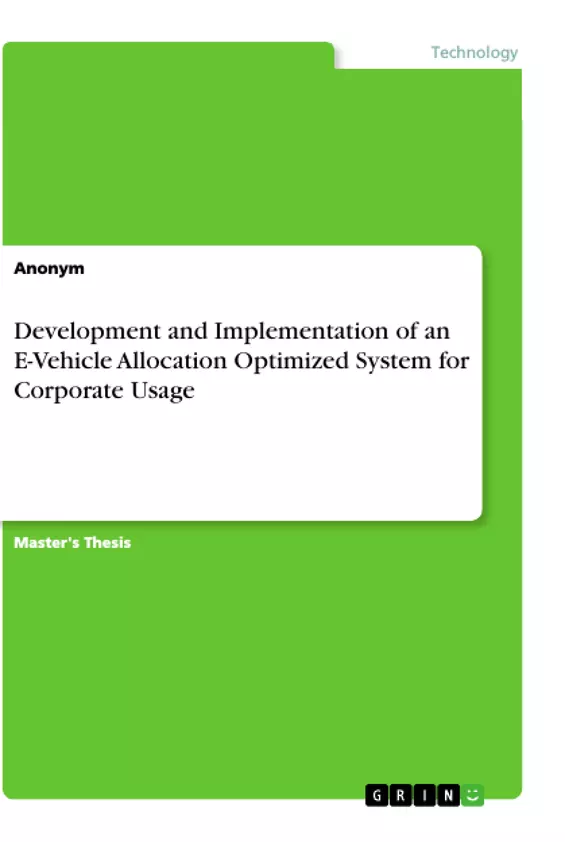This thesis is an initial approach to analyze the design and implementation of an e-vehicle sharing system in the P3 Group oÿce in Paris. An overview of the electric vehicle charging infrastructure, along with the relevant aspects of charging modes is provided. A showcase of the analysis of di˙erent car-sharing models within Europe is given, after which a specific case study is analyzed in greater detail. The parameters and features for the system were derived from a competitive benchmark of the car-sharing models on the market today. The objective was to assist the company in planning and managing a corporate e-vehicle sharing system in a profitable way while o˙ering the employees good quality service. Therefore, the cost of designing and installing the P3 EV charging station was evaluated. On this matter, empirical data was gathered from P3 employees to better understand their daily commute, their needs and their expectations of the system. An optimization model for distances, cost and charging patterns was discussed and formalized as an integer linear program in MATLAB. Given the complexity inherent to this optimization model, stochastic distribution was employed to minimize the cost for the company, taking into consideration the trips paid and the costs involved–namely, the personal wage of an employee. A focus on the optimal design of an e-vehicle sharing system was necessary, while considering the problem’s dimensionality (number of vehicles, parking places, battery capacities, etc.) and employee relocation time. This study determines if the system provides higher net benefits to the company than available transportation alternatives. As a result of this pricing comparison, a significant reduction in total cost could be achieved for the company. The data set conclusively supports the implementation of the e-vehicle sharing system, which provides a decreased cost versus the use of public transportation. A possible avenue of future research is to extend the functionality of the developed model by adding a responsive user demand and possibly, maximizing the car-sharing ridership between employees.
Inhaltsverzeichnis (Table of Contents)
- Introduction
- Motivation
- Shift towards E-Mobility
- Need for an E-Vehicle Sharing System in Paris
- Research Objective
- Thesis Structure
- Literature Review
- Electric Vehicle Charging Infrastructure
- Home Charging Equipment
- Semi-Public Charging Points
- Public Charging Stations
- Electric Vehicle Charging Modes
- Mode 1
- Mode 2
- Mode 3
- Mode 4
- Understanding Car-Sharing Systems
- Car-Sharing Principles
- Car-Sharing Models
- Free-Floating
- Stationary
- Peer-to-peer (P2P)
- Case Study Selection - Autolib’
- Design and Cost Evaluation of Electric Vehicle Charging Station
- E-Vehicle Sharing System Technology
- Technological Architecture of E-Vehicle Sharing System
- Requirements for Building an E-Vehicle Sharing System for P3 Office
- Planning Background
- Operational Issues
- Station Design
- Station Installation and Costs
- User Experience Design for the Need of P3 Employees
- Data Collection
- Survey Design
- Mobility Habits and Journey Scenarios
- User Interface Design
- Use Case Scenarios
- Application Mockup
- Development of an E-Vehicle Sharing Optimization Model
- Problem Formulation
- Mathematical Model
- Graph Theory
- Model Description
- Parameter Settings
- Model Approach - Time Independent
- Model Approach - Time Dependent
- Model Implementation
- Grey Wolf Optimizer
- Modeling in MATLAB
- Results and Analysis
Zielsetzung und Themenschwerpunkte (Objectives and Key Themes)
This master's thesis examines the design and implementation of an electric vehicle sharing system for the P3 Group office in Paris. The work aims to provide a comprehensive approach for the company to plan and manage a corporate electric vehicle sharing system that is both cost-effective and beneficial for employees.
- Electric Vehicle Charging Infrastructure and Modes
- Car-Sharing Models and Market Analysis
- User Experience Design for Corporate E-Vehicle Sharing
- Development of an Optimization Model for E-Vehicle Allocation
- Cost Evaluation and Benefit Analysis of the E-Vehicle Sharing System
Zusammenfassung der Kapitel (Chapter Summaries)
- Chapter 1 provides an introduction to the motivation behind the thesis, outlining the global shift towards electric mobility and the need for a car-sharing system at the P3 office in Paris. It also details the research objectives and the structure of the thesis.
- Chapter 2 presents a comprehensive review of the literature on electric vehicle charging infrastructure, charging modes, and car-sharing systems. It explores the different types of charging stations and charging modes, analyzes various car-sharing models, and examines the case study of Autolib’, a successful e-vehicle sharing system in Paris.
- Chapter 3 focuses on the design and cost evaluation of an electric vehicle charging station for the P3 office. It discusses the technology and architecture of the e-vehicle sharing system, identifies the requirements for building the charging station, and outlines the installation steps and associated costs.
- Chapter 4 dives into the user experience design of the e-vehicle sharing system based on data collected from P3 employees. It analyzes their mobility habits, identifies key use case scenarios, and presents a detailed mockup of the mobile application interface.
- Chapter 5 develops an optimization model for e-vehicle allocation, considering distance, cost, and charging patterns. It outlines the problem formulation, defines the mathematical model and graph theory, and describes the model implementation using the Grey Wolf Optimizer algorithm.
Schlüsselwörter (Keywords)
The main keywords and focus topics of this thesis include electric vehicle sharing, car-sharing, electric vehicle charging infrastructure, optimization modeling, cost evaluation, user experience design, mobility habits, and corporate transportation solutions.
- Quote paper
- Anonym (Author), 2018, Development and Implementation of an E-Vehicle Allocation Optimized System for Corporate Usage, Munich, GRIN Verlag, https://www.grin.com/document/455211



